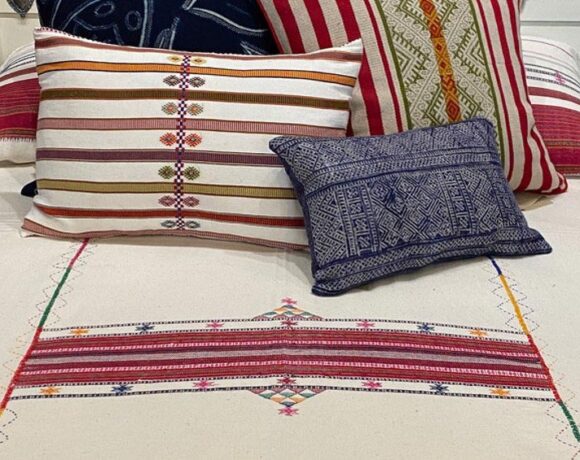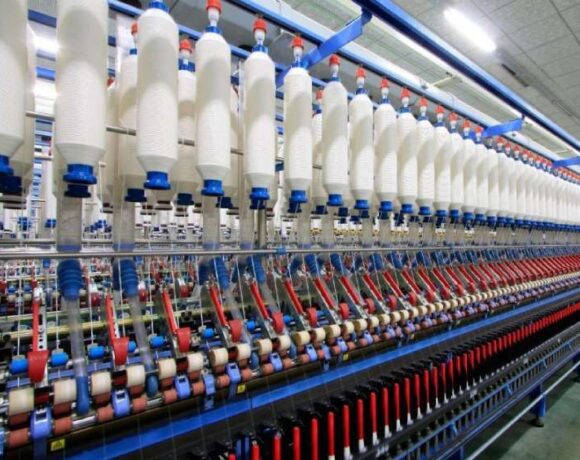Interim Budget’s Infra Push And Measures To Boost Rural Consumption Likely To Revive Textile Demand

The domestic textile and apparel sector has welcomed the Interim Budget 2024 presented by the Union Finance Minister Nirmala Sitharaman, even as it fails to meet the expectations in a true sense. Industry players and observers believe that some of the macro-economic initiatives and measures in terms of government’s commitment to fiscal consolidation with a working target of 5.1 per cent for 2024-25 and hike in capex outlay to Rs 11.11 lakh crore leading to momentum in infrastructure growth and providing boost to rural consumption through increased focus on post-harvest activities and rural housing scheme, will further bolster the economy and thereby improve the consumption of household products, including textiles and apparel in the medium to long term.
It may be noted that in the last couple of years, the domestic T&A industry is passing through a challenging situation owing to declining demand both in the export and domestic markets. The fall in domestic consumption of household products is also attributed to subdued demand condition in rural India, which normally drives the country’s overall consumption.
The Interim Budget has maintained status quo as far as tax rates are concerned, also taking care of the ongoing projects and infrastructure development activities, as the government intends to make India a developed country by 2047. The government has been giving priority for inclusive growth and infrastructure development for the past few years and the required momentum has been maintained in the Interim budget
“Even as there is not much for the T&A industry on the micro-economic front, the Interim Budget seeks to balance growth with fiscal prudence. The government’s commitment to a 4.5 per cent fiscal deficit by FY26 is indeed commendable. This augurs well for the overall economic credit creation and for inflation and private capex revival. Higher capital expenditure will drive broader economic growth while adhering to fiscal prudence. All this will fuel the growth in economy and household consumption. This augurs well for the T&A sector as a whole,” says an industry observer.

Ashok Juneja, Director, Sales & Service, Saurer Textile Solutions Pvt. Ltd.
“The Interim Budget 2024 announced by Union finance minister Nirmala Sitharaman is for the overall and continuous development of the country. The budget is all-round, all-pervasive and all-inclusive, instead of focusing on any specific sector. Though there is no significant announcement for the textile industry per se, the overall development may impact the performance of the textile Industry as well. Ease of doing business in addition to having continuous improvement in infrastructure like middle east corridor, three dedicated railway freight corridors resulting in optimising logistics cost are important highlights in this budget,” says Ashok Juneja, Director, Sales & Service, Saurer Textile Solutions Pvt. Ltd.
Importantly, the logistics sector has received a major push in the Interim Budget 2024 as the government plans to set up three major economic railway corridors to reduce congestion and logistics costs. These dedicated corridors are expected to facilitate faster movement of freight and improve turnaround times. Together with dedicated freight corridors, these three economic corridor programmes are likely to accelerate the GDP growth and reduce logistic costs. These projects have been identified under the PM Gati Shakti for enabling multi-modal connectivity.

Rajendra Agarwal, Managing Director, Donear Industries.
Currently, logistics costs account for approximately 12 per cent of India’s GDP, which hampers its competitiveness, particularly in the manufacturing sector, compared with competing countries. Industry stakeholders say that by reducing traffic on transportation routes and improving the efficiency of freight transportation, the county can increase its logistical competitiveness. This, in turn, would attract more investment into the manufacturing sector, which is currently fragmented. Any reduction in logistic cost, experts are of the view, will be a big boon for industry like textiles, which is struggling to bring down the cost to competitive levels.
“The Interim Budget is practical, balanced and progressive. It has major focus on infrastructure. Setting up of three dedicated corridors is a welcome move. These dedicated corridors are expected to facilitate faster movement of freight and improve turnaround times and thus bring down the logistic costs significantly. Creation of 20 million homes in five years for low income group will boost the economy,” says Rajendra Agarwal, Managing Director, Donear Industries.

Updeep Singh, a textile industry expert.
“Fiscal prudence instead of populism is a good sign. Expenditure in infrastructure suggests private investment to come in. Nothing much for the textile sector. However, the cabinet has approved continuation of Scheme for Rebate of State and Central Taxes and Levies (RoSCTL) for export of apparel and made-ups upto 31 March, 2026, which is a welcome step,” states Updeep Singh, a textile industry expert.

Rahul Mehta, Chief Mentor, Clothing Manufacturers Association.
“As an interim budget, it was anticipated that no significant announcements would be made, and indeed, there were no surprises. Nevertheless, the budget provided essential indicators of the anticipated direction for the July budget, emphasising key areas such as innovation, support for start-ups, sustainable development, job creation and a dedicated focus on women empowerment and domestic manufacturing, aligning with the overarching theme of ‘First Develop India’, says Rahul Mehta, Chief Mentor, Clothing Manufacturers Association.
Gurudas Aras, Former Director of A.T.E Group and Strategic Advisor to ITA Group (Germany), Rabatex Industries and Yamuna Machine Works, says that there are very few announcements concerning this important sector. Overall, the increased allocation of around 27.60 per cent for the Ministry of Textiles for the year 2024-25 when compared to the previous year, is a welcome move. This allocation will be towards various schemes including PM MITRA Park, NITTM, A-TUFS, ISDS, RoTDEP, RoSCTL, etc,, apart from making allocation for Cotton Corporation of India to exercise MSP operation for cotton.

Gurudas Aras, Former Director of A.T.E Group and Strategic Advisor to ITA Group (Germany), Rabatex Industries and Yamuna Machine Works
“The textile and apparel industry welcomes the extension of the Rebate of State and Central Taxes and Levies (RoSCTL) scheme for two years. The continuation of the RoSCTL was essential for the long-term trade planning. The scheme has seen an increased allocation from Rs 8,404.66 crore to Rs 9,246 crore,” adds Aras.
S. K. Sundararaman, Chairman, The Southern India Mills’ Association (SIMA), has welcomed the interim Union Budget, considering the Lok Sabha elections to be held shortly. Sundararaman has hoped that the demands of the textile industry relating to the raw material issues and few other industry demands might be considered in the full-fledged budget. He welcomed the overall increased allocation of around 27.60 per cent for the Ministry of Textiles for the year 2024-25.
Sundararaman further welcomed the announcement of measures to encourage green power, including bio-manufacturing, roof top solar, offshore wind, etc., so as to reduce the carbon footprint and appreciated the various pro-active initiatives in the budget to prepare the country for meeting the sustainability goals. He welcomed the continuous efforts made in strengthening the logistics infrastructure facilities, aimed at reducing the transaction costs and thereby increase the global competitiveness of the manufacturing sectors in the country.
Commenting on the interim Budget, Rakesh Mehra, Chairman, Confederation of Indian Textile Industry (CITI) says that that there has not been any major policy announcement in the present budget, being an interim budget, but the industry needs immediate relief from the financial stress, especially in the spinning sector.

S. K. Sundararaman, Chairman, The Southern India Mills’ Association (SIMA)
The budget allocation for textiles has increased by 27.6 per cent, largely due to the allocation of Rs 600 crore for CCI towards the cotton MSP operations. Mehra expressed hope that the cotton procurement will be as per revamped policies recommended by user industry associations to ensure price stability and discourage speculative trading. CITI has recommended commencement of cotton sales from February/March, depending upon the arrival pattern, retaining the MSP procured cotton as a buffer stock, releasing the cotton whenever the Indian cotton price exceeds the international price, extending a uniform fee period of 60 days for all actual users, etc.
Mehra further states that the apparel industry is happy to note the extension in the RoSCTL scheme for two years. However, in the present budget, the allocation for RoSCTL and RoDTEP has increased by 10 per cent and 5.8 per cent, respectively, which is modest. The industry is trying to enhance export performance and expects better allocations for trade promotion in the full budget to be announced after the elections.

Rakesh Mehra, Chairman, Confederation of Indian Textile Industry (CITI)
The industry appreciates the increased allocations towards PM MITRA and National Technical Textile Mission (NTTM) and research and capacity building highlighting the emphasis of the government on the investment. However, the slow uptake of PLI and an absence of alternatives to the TUFS scheme is impacting investment in the sector. The industry has also been requesting for closure of the pending TUFS cases at the earliest.
Mehra has expressed his happiness towards the focus on stimulating domestic consumption which may drive economic expansion and can be good for all manufacturing segments, including textiles, which are facing slump in demand. The commitment to maintaining a fiscal deficit of 5.1 per cent and ensuring fiscal discipline while supporting economic growth is expected to help.
“While in the present budget, the government has not made any changes in the existing BCD and indirect taxation, we are extremely sure that in the full budget in July, the government will consider the industry’s demand to remove the import duty from cotton and cotton waste as also increase the BCD on MMF yarn from the present 5 per cent to 10 per cent to curb cheaper imports and reduce blockage of working capital,” adds the CITI chief.















